
Functional amino acids to improve the immunity of pigs
Despite increased bio-security measures, pigs are often exposed to chronic sub-clinical level of diseases and climatic (heat) stress in commercial farms, causing a lower feed intake and performance. Differences in health or immune status of the pigs is one of the reasons for the large variation in the performance of pigs between commercial farms (Pastorelli et al., 2012). The optimal levels of nutrients including amino acids (AA) must be supplied with the feeds to the animals if the growth, health, and productivity of the animal are to be maintained at optimal level.
The immune system is a defense system to protect the host from invading pathogens. The gastrointestinal tract (GIT; from the stomach to colon) is a key component of the body's systemic immune system. In addition to digestion, absorption of nutrients, the gut serves as an immunological barrier by secreting digestive enzymes and hormones in the enterocytes. The importance of a healthy immunity of animals on the efficiency of nutrient utilization and growth performance is well accepted. When speaking about gut immunity, the focus is mainly on weaned piglets because of their immature digestive and immune systems associated with incidence of gut disorders such as post-weaning diarrhea. Both systemic and gut immune challenges increased after the ban of antimicrobial growth promoters (AGPs) in animal feeds in the Europe Union (EU) in 2006.
There are many feed additives used to enhance the immune status of the animals including probiotics, prebiotics, organic acids, essential oils, phytogenic, enzymes, antibiotics (in some countries) and AA. Some functional AA are involved in immune system functioning (Li et al., 2007). During immune system stimulation (ISS), nutrients are redirected away from growth and towards tissues involved in immune response (Reeds and Jahoor, 2001). This implies that the requirement some key AA for the production of compounds that are involved in the immune response will be increased. The application of the “functional AAs” concept is one of the possible solutions to maintain gut health and promote growth because it can enhance immune status, gut integrity for weaned pigs especially when sanitary and climatic conditions are challenging and the AGPs are not or less used in the diets.
The intent of this review is to discuss the roles of functional AA in immunity of pigs and their applications to improve immunity by more closely meeting AA requirements during immune challenge conditions. For more in depth review of the effects of AA on immunity of animals see Li et. al. (2007) and Wu (2010).
The immune system is an adaptive defense system to protect the host from invading pathogenic microorganisms, i.e. bacteria, viruses, fungi, and parasites (Kuby, 1994). There are two components of immune system: innate (nonspecific) and acquired (specific) immunity. The innate immune system consists of the cellular components, which include monocytes, macrophages, dendritic cells, neutrophils, natural killer cells and extracellular mediators such as cytokines, chemokines, acute phase proteins, complement system, epithelial barriers, and antimicrobial peptides (Parkin and Cohen, 2001; Tan et al., 2013).
Acquired or specific or immunity is induced by exposure to an antigen, naturally or via vaccination and developed more slowly (Kuby, 1994). Acquired immune system can be further divided into humoral and cell mediated immunity. During humoral immunity response, B lymphocytes in the blood secrete immunoglobulins (antibodies) to bind and eliminate the antigens (Parkin and Cohen, 2001). The cell-mediated immunity functions as the interaction of T cells (T lymphocytes) and their associated cytokines to eliminate intracellular antigens. Two major types of T cells are T helper (CD4+ Th) and T cytotoxic (CD8+). The CD4+ Th cells recognize foreign antigen, and assist other cells to eradicate the pathogen. The CD8+ cytotoxic cells are involved in antiviral and antitumour activity (Parkin and Cohen, 2001).
The GIT is an important component of the body's immune system because it contains greater than 1012 lymphocytes and has a greater concentration of antibodies than any other site in the body (Mayer, 2000). In addition to digestion, absorption and metabolism of nutrients, the intestinal epithelial cells (i.e. enterocytes) secrete digestive enzymes and hormones, and form an immunological barrier between the external environment (e.g. nutrients, microbes and pathogens) and the animal (Stoll and Burrin, 2006). Besides, the GIT also serves as a home for various microbes, which synthesize and degrade nutrients. Thus, the GIT is one of the most metabolically active and complex tissues in the body.
The intestinal epithelial cells also participate in the innate immune system of the GIT by their ability to secrete mucus and antimicrobial peptides (Shao et al., 2001). The mucus layer is mainly made up of mucins which are secreted along the epithelium of the GIT to protect the gut wall from damage and maintain immune function (Li et al., 2007). Besides mucins, the intestinal epithelial cells also secrete antimicrobial peptides (defensins and cathelicidins), and immunoglobulins which all together restrict the interaction of potential pathogens with the gut mucosa (Oswald, 2006). Furthermore, the epithelial cells can produce cytokines including interleukin IL-1, IL-10, IL-15, and IL-18 and chemokines, crucial for the recruitment and activation of immune cells (Stadnyk A.W., 2002).
When speaking about gut immunity, the focus is mainly on weaned piglets because they are less mature and more susceptible to immune challenges compared to mature pigs. In newborn pigs, antibodies in sow’s milk (colostrum) provide the first source of immune protection. The neonatal pig is immunologically immature until about 4 week of age (Blecha, 2001). Currently, piglets are weaned at 3 to 4 weeks of age under commercial conditions. Thus, the first few days after weaning is a stressful time and is often associated with reduced feed intake and growth and increased incidence of diarrhea due to immature digestive and immune systems. Therefore, the development and maintenance of gut immunity is crucial not only for the innate immune defense of the piglets but also for development of the immune status and performance at the later stage of life.
Pigs are often exposed to chronic sub-clinical level of disease in commercial farms, leading to a lower nutrient utilization and performance compared with what is potentially possible under good conditions, even if no clinical signs of disease are exhibited (Colditz, 2002; Pastorelli et al., 2012). A comprehensive review of Pastorelli et al. (2012) revealed that ISS especially bacterial infections of the GIT reduced body weight (BW) gain as much as 40% relative to unchallenged pigs, and the reduction in BW gain is partly due to the reduction in feed intake due to ISS. Systemic inflammation mediated by pro-inflammatory cytokines released by the innate (nonspecific) immune system is responsible for decreased feed consumption and body protein accretion (Li et al., 2007). Pro-inflammatory cytokines, particularly IL-1β, IL-6, and tumor necrosis factor (TNF)α, that are produced by stimulated macrophages, modify nutrient utilization during immune challenge, and have a direct effect on liver, brain, muscle and fat tissue (Colditz, 2002).
During ISS, nutrients are redirected away from growth and towards tissues involved in immune response (Reeds and Jahoor, 2001). Under such conditions, the liver becomes the major contributor to whole body protein synthesis, largely because of increased production of a wide range of acute phase proteins (APP), while synthesis and gain of muscle protein are reduced. Major APP in pigs include haptoglobin, fibrinogen, C-reactive protein, serum amyloid A, porcine major acute phase protein and albumin (Chen et al., 2003). These changes in rate and type of protein synthesis will have a direct impact on AA needs qualitatively and quantitatively at the tissue level (Reeds and Jahoor, 2001; Obled, 2002).
Immune cells utilizes AA, but more importantly the liver also need AA for gluconeogenesis and synthesis of APP and glutathione which are essential for immune function (Hunter and Grimble, 1994; Reeds and Jahoor, 2001). The immune status of animals greatly depends upon the availability of AA and other substrates for the synthesis of these proteins and peptides (Li et al., 2007). The AA profile required for immune functioning is different from that of AA required for muscle protein deposition (Reeds and Jahoor, 2001). As a result, AA requirements for immune functioning is not the same as for optimal growth performance. By more closely meeting AA requirements for maintaining a good immunity during ISS (e.g. sub-clinical level of disease), the negative impact of ISS on animal performance will be reduced, thereby also improving production efficiency.
In addition to primary role of serving as a building block for protein synthesis, AA are also involved in various important metabolic pathways in the body. Amino acids that regulates key metabolic pathways to improve health, survival, growth, development, lactation, and reproduction of organisms are defined as functional AA (Wu, 2009). Indeed, some function AA modulate immune system functioning at various levels, i.e. in the GIT, thymus, spleen, lymph nodes and immune cells of the circulating blood (Cunningham-Rundles, 2002). In general, AA regulate the immune system by: 1) enhancing the immune status to prevent infections, and 2) reducing or eliminating established infections such as inflammation and autoimmunity (Yoneda et al., 2009). The most important functional AA include sulfur amino acids, i.e. methionine and cysteine (SAA; Met + Cys), tryptophan (Trp), threonine (Thr), glutamine (Gln), arginine (Arg) and glycine (Gly; Li et al., 2007). In the following, the most important functions beyond growth and beneficial effects of dietary supplementation with these functional AA mainly in pigs are summarized.
Cysteine is also needed to produce taurine which is important for immune functioning by acting as a cell membrane stabilizer and antioxidant (Grimble, 2002), and it is particularly abundant in leucocytes (Roth, 2007). For immune function, the utilization of Cys for the production of compounds that are involved in the immune response, such as GSH, taurine and APP is increased (Grimble, 2002). This implies that the need for Met to supply Cys also increases during immune challenge situations.
Immune system stimulation by lipopolysaccharides (LPS) injection per se does not affect the ileal digestibility of AA and energy but it reduced the ratio of whole-body nitrogen (N) and sulfur (S)balance indicating that SAA are preferentially preserved in favor of non-protein compounds such as glutathione to enhance immune status (Rakhshandeh et al., 2010). Rakhshandeh et al. (2014) found that ISS reduced protein deposition (Pd) and decreased daily SAA requirement (Fig. 1). However, ISS increased he maintenance SAA requirements, e.g. to achieve a constant PD of 50 g/d, unchallenged (ISS-) pigs need 1.63 g SID SAA intake while immune challenged (ISS+) pigs need 1.87 g SID SAA intake (i.e. 15% increase).
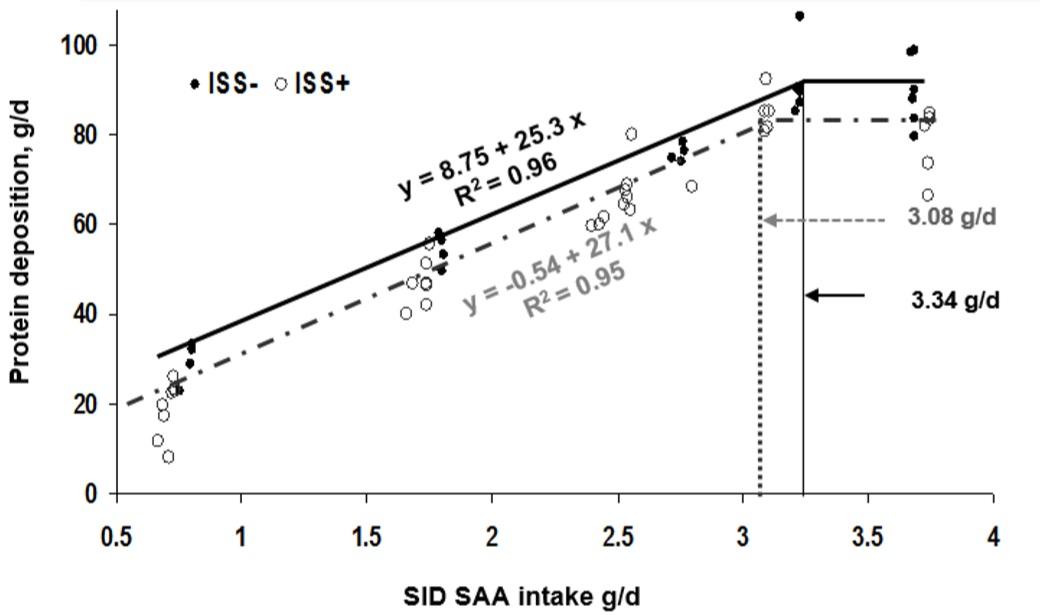
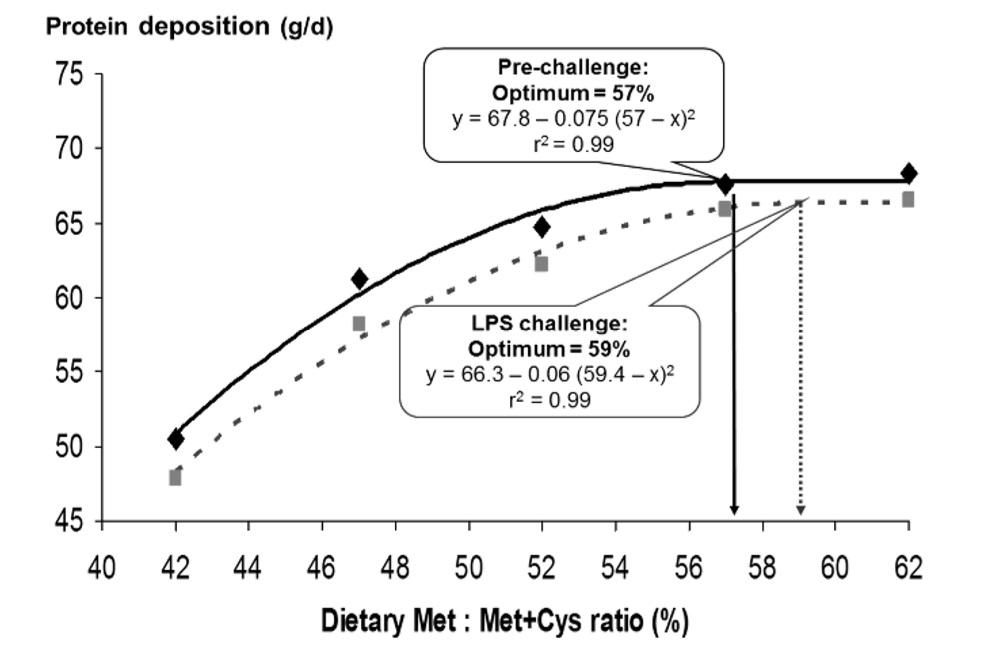

In addition to being involved in protein synthesis and serotonin regulation, Trp is also is needed for modulation of the immune function through kynurenine pathway initiated by two enzymes. The enzyme tryptophan-2, 3-dioxygenase (TDO) in the liver regulates homeostatic plasma Trp concentration and another enzyme, indoleamine-2, 3-dioxygenase (IDO), which presents in various body tissues including intestine, stomach, lungs, brain and macrophages, is induced by inflammatory cytokine IFN-γ during immune system stimulation (Botting, 1995). More than 95% of dietary Trp, not utilized for protein synthesis, is metabolized through the kynurenine pathway forming various products including kynurenic acid and niacin.
Studies have shown that lung inflammation in pigs reduced plasma Trp levels (Melchior et al., 2004; Fig. 3) and increased IDO activity in lungs and associated lymph nodes (Le Floc’h et al., 2008) than pair-fed healthy piglets. Furthermore, they observed that piglets fed a low Trp diet had a higher plasma concentration of a major acute phase protein haptoglobin (which is relatively high in Trp content) compared with pigs fed a Trp-adequate diet. These results suggest that the use of Trp for the synthesis of kynurenine is increasedduringimmune challenge. Furthermore, Trp can be used to synthesize a neurohormone melatonin, which may act as free radical scavengers and have antioxidant properties (Le Floc'h and Seve, 2007).
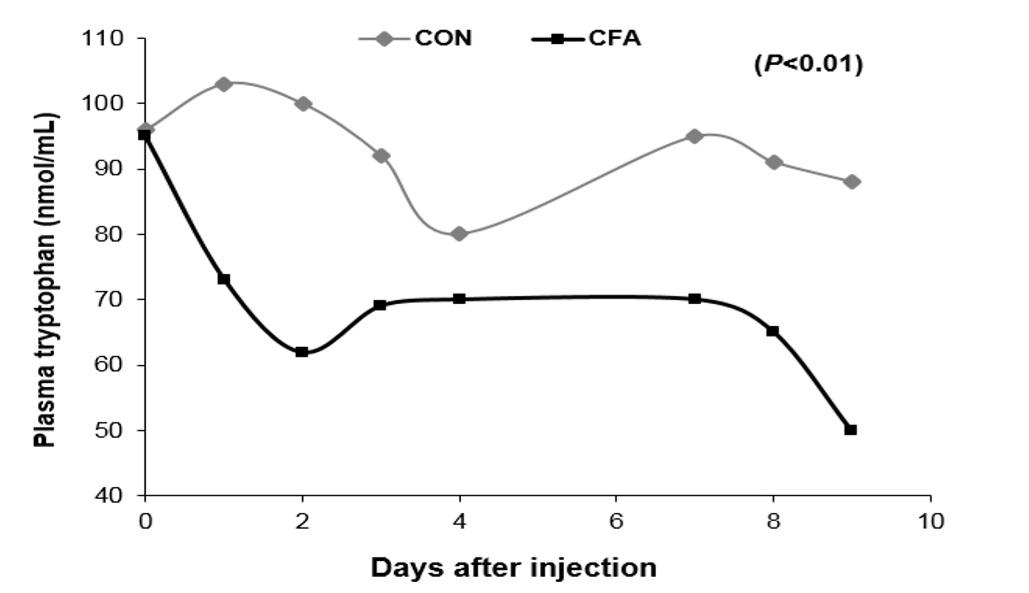
Figure 3: Plasma tryptophan concentration in pigs with lung inflammation (CFA, complete Freund’s adjuvant) and control (CON) healthy paired-fed weaned pigs (Melchior et al., 2004).


Cuaron et al. (1984) showed that sows fed a diet adequate in Thr (sorghum and L-Thr based) had 20% more IgG in their plasma than sows fed the Thr-deficient diet at farrowing. Supplementing a low protein diet with 0.14% L-Thr during gestation increased milk IgG concentration at farrowing and during lactation (Hsu et al., 2001). Supplementation with L-Thr to contain a dietary Thr level higher than for optimal growth (i.e. Thr:Lys ratio of 99%) increased the production of serum antibody and IgG levels in 17-31 kg pigs challenged with bovine serum albumin (Li et al., 1999). Similarly, Wang et al. (2006) reported that the serum IgG level maximized at a higher dietary Thr level (SID Thr:Lys of 78%) while optimal growth performance was achieved at a SID Thr: Lys of 69% for 10-25 kg pigs challenged with ovalbumin injection (Fig. 5).
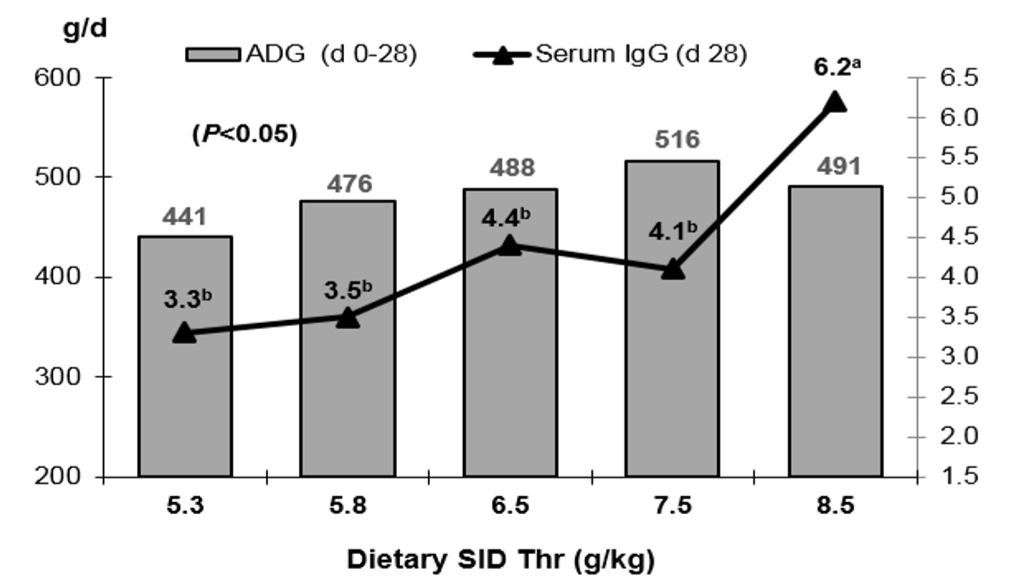
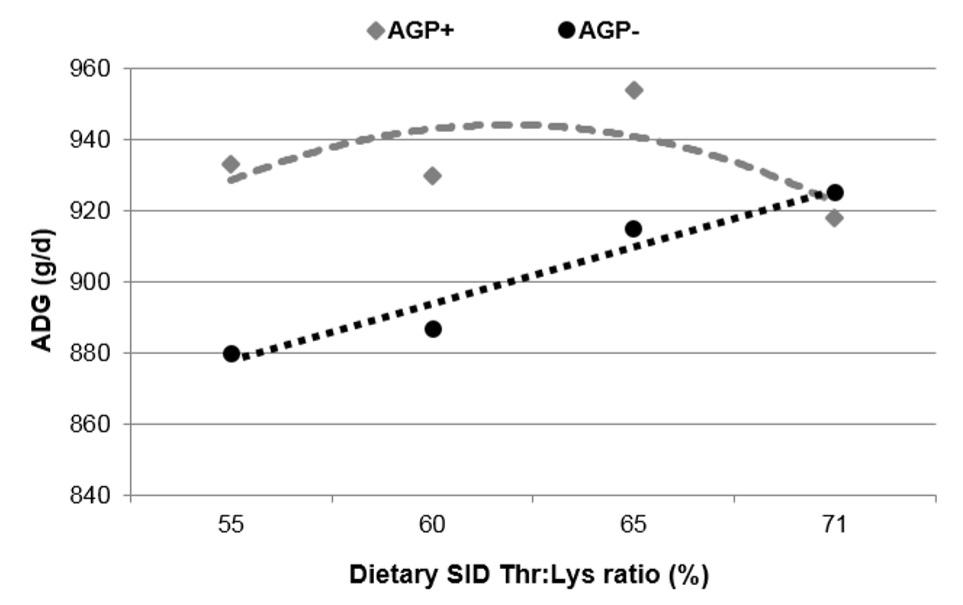 Figure 6: Effect of dietary SID Thr:Lys ratio on average daily gain (ADG) of 25-110 kg pigs fed diets with or without AGP (Bikker et al., 2006)
Figure 6: Effect of dietary SID Thr:Lys ratio on average daily gain (ADG) of 25-110 kg pigs fed diets with or without AGP (Bikker et al., 2006)




This review paper summarizes the regulation of immune system including the gut immunity and their importance for achieving optimal performance and production efficiency. In addition to protein synthesis, AA are also involved in various important metabolic pathways including modulating immune system at various levels in the body. The roles of function AA for the immune functioning has received more attention during the last decade. During sub-clinical level of diseases, nutrients are prioritized to form tissues involved in immune response compromising growth, implying that the increased level of some key AA should be increased to maintain a good immunity and to reduce the negative impact on animal performance. The application of the “functional AA” concept is one of the possible solutions to maintain gut health and promote growth because it can enhance immune status, gut integrity for weaned pigs especially when sanitary and climatic conditions are challenging, and the AGPs are not or less used in the diets. The roles beyond growth and beneficial effects of dietary supplementation with the main functional AA, i.e. Met + Cys, Trp, Thr, Gln, Arg and Gly in pigs are described. Future research is warranted to quantitatively estimate the increased need of these functional AA to excerpt improvement in immunity, gut health and performance of pigs raised under sub-optimal conditions. Furthermore, there is a need to access the interaction or synergetic effect of various amino acids on animal’s immunity.







